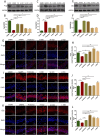Xixin Decoction's novel mechanism for alleviating Alzheimer's disease cognitive dysfunction by modulating amyloid-β transport across the blood-brain barrier to reduce neuroinflammation
- PMID: 39834810
- PMCID: PMC11743276
- DOI: 10.3389/fphar.2024.1508726
Xixin Decoction's novel mechanism for alleviating Alzheimer's disease cognitive dysfunction by modulating amyloid-β transport across the blood-brain barrier to reduce neuroinflammation
Abstract
Purpose: Xixin Decoction (XXD) is a classical formula that has been used to effectively treat dementia for over 300 years. Modern clinical studies have demonstrated its significant therapeutic effects in treating Alzheimer's disease (AD) without notable adverse reactions. Nevertheless, the specific mechanisms underlying its efficacy remain to be elucidated. This investigation sought to elucidate XXD's impact on various aspects of AD pathology, including blood-brain barrier (BBB) impairment, neuroinflammatory processes, and amyloid-β (Aβ) deposition, as well as the molecular pathways involved in these effects.
Methods: In vitro experiments were conducted using hCMEC/D3 and HBVP cell coculture to establish an in vitro blood-brain barrier (BBB) model. BBB damage was induced in this model by 24-h exposure to 1 μg/mL lipopolysaccharide (LPS). After 24, 48, and 72 h of treatment with 10% XXD-medicated serum, the effects of XXD were assessed through Western blotting, RT-PCR, and immunofluorescence techniques. In vivo, SAMP8 mice were administered various doses of XXD via gavage for 8 weeks, including high-dose XXD group (H-XXD) at 5.07 g kg-1·d-1, medium-dose XXD group (M-XXD) at 2.535 g kg-1·d-1, and low-dose XXD group (L-XXD) at 1.2675 g kg-1·d-1. Cognitive function was subsequently evaluated using the Morris water maze test. BBB integrity was evaluated using Evans blue staining, and protein expression levels were analyzed via ELISA, Western blotting, and immunofluorescence.
Results: In vitro experiments revealed that XXD-containing serum, when cultured for 24, 48, and 72 h, could upregulate the expression of P-gp mRNA and protein, downregulate CB1 protein expression, and upregulate CB2 and Mfsd2a protein expression. In vivo studies demonstrated that XXD improved spatial learning and memory abilities in SAMP8 mice, reduced the amount of Evans blue extravasation in brain tissues, modulated the BBB-associated P-gp/ECS axis, RAGE/LRP1 receptor system, as well as MRP2 and Mfsd2a proteins, and decreased the accumulation of Aβ in the brains of SAMP8 mice. Additionally, XXD upregulated the expression of TREM2, downregulated IBA1, TLR1, TLR2, and CMPK2 expression, and reduced the levels of pro-inflammatory factors NLRP3, NF-κB p65, COX-2, TNF-α, and IL-1β in the hippocampal tissues.
Conclusion: XXD may exert its effects by regulating the P-gp/ECS axis, the RAGE/LRP1 receptor system, and the expression of MRP2 and Mfsd2a proteins, thereby modulating the transport function of the BBB to expedite the clearance of Aβ, reduce cerebral Aβ accumulation, and consequently inhibit the activation of microglia induced by Aβ aggregation. This process may suppress the activation of the CMPK2/NLRP3 and TLRs/NF-κB pathways, diminish the production of inflammatory cytokines and chemokines, alleviate neuroinflammation associated with microglia in the brain of AD, and ultimately improve AD pathology.
Keywords: Alzheimer’s disease; Xixin Decoction; amyloid-beta; blood-brain barrier; neuroinflammation.
Copyright © 2025 Yang, Zhao, Zhang, Duan, Han, Ding, Cheng, Wang, Lei and Diwu.
Conflict of interest statement
The authors declare that the research was conducted in the absence of any commercial or financial relationships that could be construed as a potential conflict of interest.
Figures









Similar articles
-
[Xixin Decoction improves learning and memory ability of SAMP8 by enhancing neuroprotective effect and inhibiting neuroinflammation].Zhongguo Zhong Yao Za Zhi. 2023 Sep;48(18):5032-5040. doi: 10.19540/j.cnki.cjcmm.20230419.406. Zhongguo Zhong Yao Za Zhi. 2023. PMID: 37802845 Chinese.
-
[Effect of Erjing Pills on alleviating neuroinflammation of AD rats based on TLR4/NF-κB/NLRP3 pathway and its mechanism].Zhongguo Zhong Yao Za Zhi. 2023 Feb;48(3):770-777. doi: 10.19540/j.cnki.cjcmm.20221014.704. Zhongguo Zhong Yao Za Zhi. 2023. PMID: 36872241 Chinese.
-
[Mechanism of Daotan Xixin Decoction in treating APP/PS1 mice based on high-throughput sequencing technology and bioinformatics analysis].Zhongguo Zhong Yao Za Zhi. 2025 Jan;50(2):301-313. doi: 10.19540/j.cnki.cjcmm.20241011.401. Zhongguo Zhong Yao Za Zhi. 2025. PMID: 39929612 Chinese.
-
Role of the blood-brain barrier in the pathogenesis of Alzheimer's disease.Curr Alzheimer Res. 2007 Apr;4(2):191-7. doi: 10.2174/156720507780362245. Curr Alzheimer Res. 2007. PMID: 17430246 Review.
-
Exercise training exerts beneficial effects on Alzheimer's disease through multiple signaling pathways.Front Aging Neurosci. 2025 May 21;17:1558078. doi: 10.3389/fnagi.2025.1558078. eCollection 2025. Front Aging Neurosci. 2025. PMID: 40469843 Free PMC article. Review.
Cited by
-
Biological functions and clinical implications of the CMPK2 across multisystemic diseases.Cell Biosci. 2025 Aug 27;15(1):122. doi: 10.1186/s13578-025-01466-y. Cell Biosci. 2025. PMID: 40867000 Free PMC article. Review.
References
-
- Barabási B., Barna L., Santa-Maria A. R., Harazin A., Molnár R., Kincses A., et al. (2023). Role of interleukin-6 and interleukin-10 in morphological and functional changes of the blood-brain barrier in hypertriglyceridemia. Fluids Barriers CNS 20 (1), 15. 10.1186/s12987-023-00418-3 - DOI - PMC - PubMed
LinkOut - more resources
Full Text Sources
Research Materials
Miscellaneous

